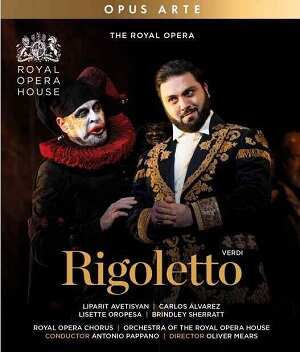
Giuseppe Verdi (1813–1901)
Rigoletto, opera in three acts (1851)
Libretto by Francesco Maria Piave
Carlos Álvarez: Rigoletto
Lisette Oropesa: Gilda
Liparit Avetisyan: Il Duca
Ramonza Zaharia: Maddalena
Brindley Sherratt: Sparafucile
Eric Greene: Monterone
Orchestra and Chorus of the Royal Opera House/Sir Antonio Pappano
Oliver Mears (stage direction)
rec. live, 16 & 24 September 2021, Royal Opera House, Covent Garden, London
Reviewed in surround sound
OPUS ARTE OABD7303D Blu-Ray [147]
Oliver Mears has been the Director of Opera at the Royal Opera House, Covent Garden, since 2017. This is his first production for the house, opening the 2021-2022 season after the many programming uncertainties of the Covid pandemic. The curtain rises to show an atmospherically lit still life based on Caravaggio’s The Martyrdom of St Matthew (Rome 1600). This, appropriately enough, was an event provoked by a powerful king’s lust for a young woman, who was his niece and a nun. So the evangelist is replaced by a young woman in white. The soldier sent to assassinate Matthew wears a breastplate and the skull of a bull, complete with golden horns, later removed to reveal the Duke of Mantua. The woman is Count Monterone’s pregnant daughter. Other large renaissance paintings feature later. Titian’s Venus of Urbino dominates Act 1, and in Act 2 his Rape of Europa hangs over the door to the bedchamber where the kidnapped Gilda lies.
The staging is monumental, with little encumbering detail. Simon Lima Holdsworth’s set for the Ducal court has, as explained in the short extra on the disc, the “leathered texture of a gentleman’s club”, privileged and exclusive. In Act 3, its walls rearrange to depict Sparafucile’s tavern-cum-brothel, and Maddalena’s bedroom is seen above. The solitary tubular steel chair hardly suggests a cosy interior to shelter from the imminent storm. Ilona Karas’s costumes look Renaissance for scene 1, but Monterone arrives in a suit, and Rigoletto, white jester’s face removed as he leaves the court, is dressed in hat and raincoat from a 1940s film noir. Sparafucile, the tattooed neighbourhood knife for hire, is in what might pass for a humble assassin’s contemporary workwear. Gilda is plainly attired, allowed no colour or frills by her father, lest she draw attention to her charms.
The extra also shows the singers speak of working with Mears, ideas and movement evolving from close work on the libretto and the play of Victor Hugo on which it is based. The direction of the principals is mostly convincing, both individually and in relation to one another. Rigoletto, though, could not spit out the consonants of his ferocious condemnation of the court Cortigiani, vil razza dannata as Mears has him on his knees before that “vile, damned race”. The chorus is directed less well, in this scene reduced to synchronised cigarette lighting as a show of contempt! Only a few details like that seem gratuitous, but they surely include the Duke’s gouging out of Monterone’s eyes.
The cast is strong. A high standard is set by leading coloratura soprano Lisette Oropesa, who is near-ideal as Gilda. Caro nome, with floated high notes, sometimes reduced to a thread of tone but still secure, a real trill, and a sustained lyrical line, was almost perfect. Her Act 2 confession to her father Tutte le feste actually is perfect, as it requires her to do all that fabulous vocalising, but also indicates that this situation is far harder for her, given she has been abducted and now must confess to her father the behaviour that led to that.
Carlos Álvarez is now a veteran Rigoletto. If vocally it shows at times, overall his experienced singing serves the work very well. His Piangi, fanciulla in response to Gilda’s confession is moving indeed. But he and Oropesa both sing – and act – so well here that we are aware that we are hearing and seeing the very heart of the drama in this father-daughter relationship, one often found in Verdi’s operas. Indeed, Verdi wanted to set King Lear, but perhaps felt he had covered the Lear-Cordelia relationship quite enough, and especially in Rigoletto.
Liparit Avetisyan is an impressive Duke. His two crowd-pleaser numbers Questa o quella and La donna è mobile have style and an aristocratic elegance. He also acts well. We almost believe he means it when he says Gilda’s the one who could make him love her for ever. Brindley Sherratt’s dark bass suits Sparafucile’s dark soul, while Ramona Zaharia’s excellent Maddalena sings well both solo and in ensemble. Monterone has been more strongly cast vocally perhaps, his curse on Rigoletto not as terrifying as it should be, but the other comprimarios are good.
Is there a conductor you would rather have in the pit for core Italian opera repertoire than Antonio Pappano? Chailly or Muti maybe, but Pappano clearly belongs in their league. The orchestral playing, usually so accomplished in this house anyway, goes up a level if he is on the podium. There is the usual thin booklet (English synopsis and little else), but importantly we get the usual excellent production values on the disc. There is good surround sound, and plenty of visual detail within the dark images. I do not know any of the other recent versions, but I believe that if you are in the market for a fine Rigoletto filmed on stage, this one has to be on your short list.
Roy Westbrook
Help us financially by purchasing from



Other singers
Egor Zhuravskii: Borsa
Blaise Malaba: Count Ceprano
Amanda Baldwin: Countess Ceprano
Dominic Sedgwick: Marullo
Ksenia Nikolaieva:Giovanna
Louise Armit: Page
Nigel Cliffe: Court Usher
Production staff and technical details
Set designer: Simon Lima Holdsworth
Costume designer: Ilona Karas
Lighting designer: Fabiana Piccioli
Movement director: Anna Morrisey
Directed for the screen by Peter Jones
Video Aspect ratio: 16:9
Audio Formats: LPCM 24 bit STEREO 2.0, DTS 5.1 HD Master Audio
Region code: 0 – All regions
Subtitles: English, French, German, Japanese, Korean
Booklet with synopsis (English only)


















